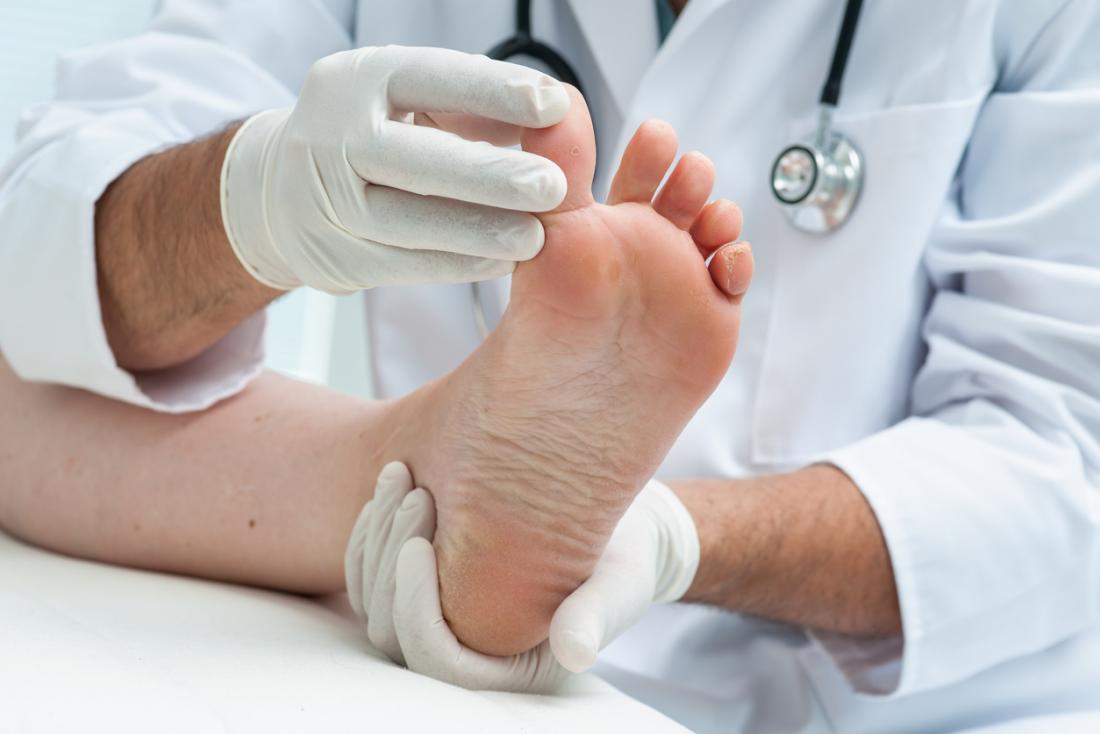SYMPTOMS OF A BROKEN ANKLE INCLUDE:
- Bruising
- Deformity, particularly if there is a dislocation as well as a fracture
- Immediate and severe pain
- Inability to put any weight on the injured foot
- Swelling
- Tender to the touch
Treatment options include a leg cast or brace if the fracture is stable. If the ligaments are also torn, or if the fracture created a loose fragment of bone that could irritate the joint, surgery may be required to “fix” the bones together so they will heal properly.
Fractures

Nearly one-fourth of all the bones in your body are in your feet. A broken (fractured) bone in your forefoot or in one of your toes is often painful but rarely disabling. Most of the time, these injuries heal without operative treatment. Types of fractures include stress fractures and general bone fractures.
Stress fractures frequently occur in the bones of the forefoot extending from your toes to the middle of your foot. Stress fractures are like tiny cracks in the bone surface. They can occur with sudden increases in training (such as running or walking for longer distances or times), improper training techniques or changes in training surfaces.
Most other types of fractures extend through the bone. They may be stable, in which there is no shift in bone alignment, or displaced, in which the bone ends no longer line up properly. These fractures usually result from trauma, such as dropping a heavy object on your foot, or from a twisting injury. If the fractured bone does not break through the skin, it is called a closed fracture. Several types of fractures occur to the forefoot bone on the side of the little toe (fifth metatarsal).
An ankle-twisting injury may tear the tendon that attaches to this bone and pull a small piece of the bone away. A more serious injury in the same area is a Jones fracture, which occurs near the base of the bone and disrupting the blood supply to the bone. This injury may take longer to heal or require surgery. Symptoms include pain, swelling, and sometimes bruising.
Osteochondritis (stiff ankle)
Osteochondritis Dessicans are lesions that usually cause pain and stiffness of the ankle joint and affect all age groups. Often, Osteochondritis usually follow a twisting type injury to the ankle.
Osteochondritis may cause swelling and ankle pain. When immobilization of the injury doesn’t alleviate the problem, surgery is sometimes prescribed. The procedure usually involves removing the loose fragment of cartilage and bone from the ankle joint and placing small drill holes in the defect. The drill holes stimulate new blood vessels to fill the area and help form scar tissue to fill the defect.
Osteochondromas
Osteochondromas are benign bone tumors under the toenail. They form in the bone beneath the toenail. An osteochrondroma accounts for about half of all benign bone tumors, occurring mostly in children and young adults. Unless they cause irritation to the surrounding tissue, they are generally not very painful.
Sometimes, they can deform the toenail and cause an ingrown toenail. In some cases, they are removed surgically, but can recur even after the procedure.
Shin Splints
Shin splints are pain to either side of the leg bone, caused by muscle or tendon inflammation. It is commonly related to a collapsing arch, but may be related to a muscle imbalance between opposing muscle groups in the leg.
Proper stretching and corrective shoes or shoe inserts for pronation can help prevent shin splints.
Sports Injuries
Martial arts and kick boxing
A variety of injuries can occur as a result of martial arts and kick boxing. These include plantar fasciitis, Achilles tendonitis, sesamoiditis, and ankle sprains. Stretching is recommended for a minimum of 15 minutes before performing any kicking or punching.
AEROBICS
Proper shoes are crucial to successful, injury-free aerobics. Shoes should provide sufficient cushioning and shock absorption to compensate for pressure on the foot many times greater than found in walking. They must also have good medial-lateral stability. Impact forces from aerobics can reach up to six times the force of gravity, which is transmitted to each of the 26 bones in the foot.
TEAM SPORTS
Activities such as football, basketball, soccer, field hockey and lacrosse often lead to ankle and big toe joint injuries as a result of play on artificial surfaces.
TURF TOE
Big toe injuries also called “turf toe,” often result from hyperextension of the big toe joint as the heel is raised off the ground. An external force is placed on the great toe and the soft tissue structures that support the big toe on the top are torn or ruptured.
Symptoms include pain, tenderness and swelling of the toe joint. Often there is a sudden acute onset of pain during push-off phase of running. Usually, the pain is not enough to keep the athlete from physical activities or finishing a game. This causes further injury to the big toe and will dramatically increase the healing time.
Treatment includes rest, ice, compression, and equipment modification or change. Non-steroidal anti-inflammatory drugs (NSAIDs) may be used for relief of minor pain as well as to decrease the inflammation of the injury. Consult with our physicians before taking any medication.


